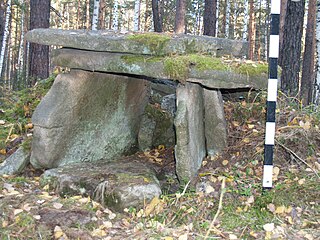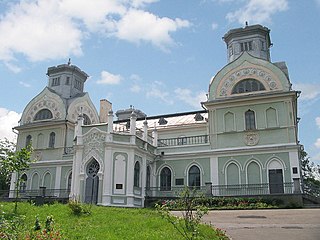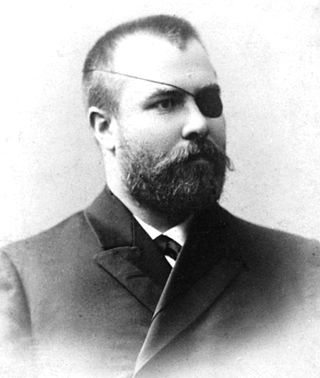
Magna Hungaria, literally "Great Hungary" or "Ancient Hungary", refers to the ancestral home of the Hungarians.

The Shamkhalate of Tarki, or Tarki Shamkhalate was a Kumyk state in the eastern part of the North Caucasus, with its capital in the ancient town of Tarki. It formed on the territory populated by Kumyks and included territories corresponding to modern Dagestan and adjacent regions. After subjugation by the Russian Empire, the Shamkhalate's lands were split between the Empire's feudal domain with the same name extending from the river Sulak to the southern borders of Dagestan, between Kumyk possessions of the Russian Empire and other administrative units.

In recent years, many megaliths have been discovered in the Urals: dolmens, menhirs and a large megalithic cultic complex on Vera Island.

Arts of Caucasian Albania – is the historical and regional type of arts related to Ancient East.

The Kórmchaia Book, also known as the Books of the Pilot (Russian: Ко́рмчая книга, Ко́рмчая from кормчий, Church Slavonic: кръмьчии 'helmsman, ship's pilot'; Pidalion or Nomocanon, are collections of church and secular law, which constituted guide books for the management of the church and for the church court of Orthodox Slavic countries and were also the transmission of several older texts. They were written in Old Church Slavonic and Old East Slavic.
Utyz Imyani, Gabdrakhim — was a tatar poet. In the Islamic world he was also known as a scientist and recoverer of lost fragments of an ancient Quran.
Nikolai Vasilyevich Rumyantsev was a Soviet author of several polemics on the history of Christianity, translator. He was also a member of the Soviet circle "Atheist" and the League of Militant Atheists. In the 1920s Rumyantsev was one of the leading proponents of the so-called mythological school in the Soviet academia. He authored such publications, as "The Pre-Christian Christ", "The Pagan Christs – the Ancient Precursors of Christianity", "The Apocalypse – The Revelation of John" and "Orthodox Holidays, Their Origin and Class Essence" (1936). "The Apocalypse – The Revelation of John" was published under the influence of Abram Ranovich. In that publication Rumyantsev, while not explicitly retracting his earlier opinions, offered a study of early Christianity which stressed not its derivation from supposed ancient mythology, but its intrinsic relation to revolutionary, messianic elements in contemporary Judaism.
The Kushnarenkovo culture is an archaeological culture of the Iron Age in the Southern Ural. First described V. F. Gening on the basis of excavations carried out in 1955–1959 years in the cemetery in Kushnarenkovo (Bashkortostan).
The Turbasli culture - archaeological culture 5th-7th centuries b.c., it is located on the left bank of the middle reaches of the Belaya River, between the mouths of Sim and Chermasan. Opened by N.A.Mazhitov in 1957–1958. Materials excavation: New Turbasli settlement, burial mound in the Blagoveshchensky District, Republic of Bashkortostan etc.

The Lopukhin family was a noble family of the Russian Empire, forming one of the branches of the Sorokoumov-Glebov family.
Ivan Anatolievich Shpitsberg, was a Russian and Soviet lawyer, journalist, writer, translator, organizer, and head of the scientific society and publishing house Atheist (1921), and editor of the eponymous magazine.
Anton Loginov was a Russian Bolshevik Revolutionary, Communist Party member, journalist, writer, Soviet publicist, and propagandist of atheism.
The Kobuzev family is an ancient Russian noble family descended from Ryazanian boyar scions.
Mark Mendelevich Persits was a Soviet propagandist of atheism, a scientific worker in the study of problems of religion and atheism, a writer, and a historian of social thought.
Ivan Aleksandrovich Flerov was a Soviet educationist, journalist, and writer on problems of religion and atheism.

Vladimir Kapitonovich Nikolsky was a Soviet historian, ethnologist, translator, religious scholar, Doctor of Historical Sciences (1943), and professor.

Vladimir Konstantinovich Soldatov was a Russian and Soviet ichthyologist, zoologist, Doctor of Biological Sciences, professor of the Department of Ichthyology of the Moscow Technical Institute for the Fishery Industry.

Matvey Kuzmich Lyubavsky was a Russian and Soviet historian, professor, academic and rector of the Moscow University from 1911 to 1917.
The Alexievsky Cross is a fourteenth century inlaid stone wayside cross installed on the western wall of the Sophia Cathedral in Weliky Novgorod. It is named for Archbishop Alexei of Novgorod, who originally commissioned it.









